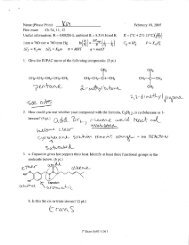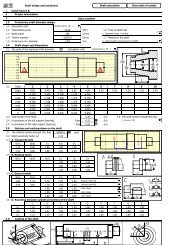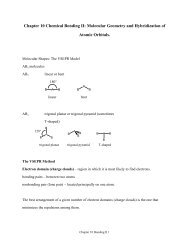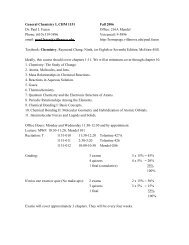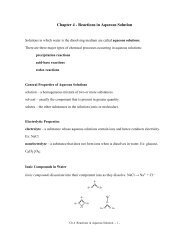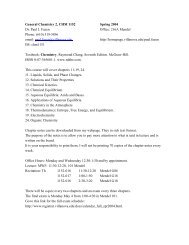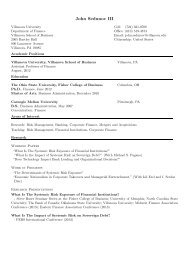A Culture of Collaborative Inquiry: Learning to Develop and Support ...
A Culture of Collaborative Inquiry: Learning to Develop and Support ...
A Culture of Collaborative Inquiry: Learning to Develop and Support ...
Create successful ePaper yourself
Turn your PDF publications into a flip-book with our unique Google optimized e-Paper software.
Borko, 2000; Radinsky, Bouillion, Len<strong>to</strong>, & Gomez, 2001).Pr<strong>of</strong>essional development focused on collaborative inquiry can besupported <strong>and</strong> facilitated through specific means, usually by auniversity pr<strong>of</strong>essor <strong>and</strong>/or district specialist, or by one or all <strong>of</strong> theteachers themselves. The type <strong>of</strong> support reported in the literatureis quite varied, but it is clear that specific kinds <strong>of</strong> support arecrucial for allowing teachers the time, place, <strong>and</strong> intellectualcapacity <strong>to</strong> collaboratively inquire in<strong>to</strong> their practice (Gamoran etal., 2003; Nelson & Slavit, in press).Although the literature on teacher collaborative inquiry isemerging, there is a paucity <strong>of</strong> both empirical <strong>and</strong> descriptiveevidence on the pr<strong>of</strong>essionals who design its structure <strong>and</strong> supportteachers as they engage in this process. Elliott (2005) reported anextensive search on the development <strong>of</strong> mathematics pr<strong>of</strong>essionaldevelopers that yielded only four results (Davenport & Ebby,2000; Even, 1999; Even, Robinson, & Carmeli, 2003; Stein, Smith,& Silver, 1999), all <strong>of</strong> which used case studies <strong>to</strong> describe theinherent challenges in facilitating the development <strong>of</strong> leaders.Although these studies do ground the case discussion in thebroader pr<strong>of</strong>essional development context, there is littleinformation on the overall planning contexts that led <strong>to</strong> theconstruction <strong>and</strong> implementation <strong>of</strong> the project as a whole. Forexample, Stein et al. concluded that ―by providing up-close views<strong>of</strong> a few pioneers actually attempting <strong>to</strong> assist teachers in newsettings <strong>and</strong> in new ways, we have begun <strong>to</strong> map the terri<strong>to</strong>ry <strong>of</strong>what pr<strong>of</strong>essional developers must learn in order <strong>to</strong> be successful‖(p. 266).Although helpful, these studies do not address the broader scope<strong>and</strong> context <strong>of</strong> planning, organizing, <strong>and</strong> delivering pr<strong>of</strong>essionaldevelopment. If pr<strong>of</strong>essional development that supports teachers inreconceptualizing beliefs <strong>and</strong> practice is <strong>to</strong> be examined, then moredata are needed <strong>to</strong> support pr<strong>of</strong>essional developers in similarreconceptualizations regarding the overall planning <strong>and</strong> execution<strong>of</strong> ―transformative‖ pr<strong>of</strong>essional development (Ball & Cohen,1999; Thompson & Zeuli, 1999).Similar <strong>to</strong> teacher action research, self-inquiry by a team <strong>of</strong>pr<strong>of</strong>essional developers as they plan <strong>and</strong> deliver a long-term, largescaleproject was identified by the authors as a method forunderst<strong>and</strong>ing how <strong>to</strong> reconceptualize <strong>and</strong> enact transformativepr<strong>of</strong>essional development. Specifically, this research is about a 12-member group, known as the ―steering committee‖ (SC), whosemembers came <strong>to</strong>gether <strong>to</strong> design <strong>and</strong> implement a 3-yearpr<strong>of</strong>essional development project for secondary science <strong>and</strong>mathematics teachers. To better underst<strong>and</strong> the structures <strong>and</strong>processes for collaborative inquiry that we (―we‖ refers <strong>to</strong> thesteering committee) were setting up <strong>and</strong> facilitating for theteachers, we deliberately set out <strong>to</strong> use these same structures <strong>and</strong>processes ourselves as we worked <strong>to</strong>gether on the project. Theresults <strong>of</strong> our own inquiry in<strong>to</strong> pr<strong>of</strong>essional development are thefocus <strong>of</strong> this article. Specifically, this article provides a narrative <strong>of</strong>how <strong>and</strong> what we learned about supporting teachers engaged ininquiry-oriented pr<strong>of</strong>essional learning communities while we didso ourselves. Three <strong>of</strong> the authors (excluding Mart) were fullparticipants on the SC <strong>and</strong> have attempted, through data analysis<strong>and</strong> member checking, <strong>to</strong> fully represent the perspectives <strong>and</strong>processes <strong>of</strong> the group. Implications for teacher pr<strong>of</strong>essionaldevelopers relative <strong>to</strong> group norms <strong>and</strong> cohesiveness acrossdifferent areas <strong>of</strong> expertise, interests, <strong>and</strong> agendas, as well aspotential impact on teacher participants, are explored.CONTEXTPartnerships for Reform in Secondary Science <strong>and</strong> Mathematics(PRiSSM) is a 3-year pr<strong>of</strong>essional development project, funded bythe U.S. Department <strong>of</strong> Education, designed <strong>to</strong> help teachers from22 schools in six school districts undertake collaborative inquiryin<strong>to</strong> some aspect <strong>of</strong> their practice. Because teacher pr<strong>of</strong>essional2 | P a g e



